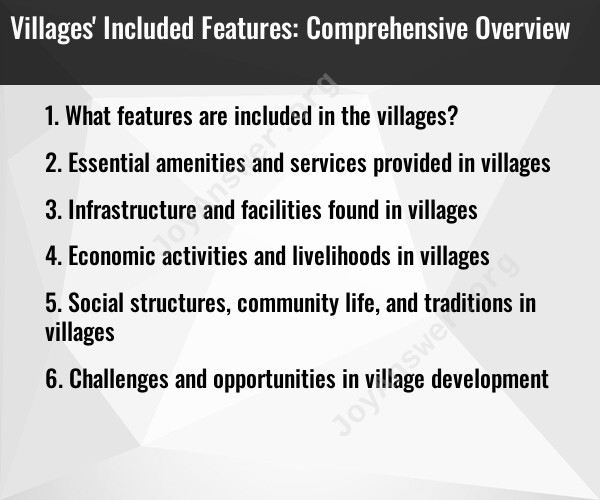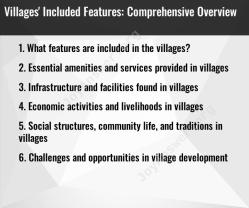What features are included in the villages?
The features included in villages can vary significantly based on their type, purpose, location, and the services they aim to provide. "Villages" can refer to various types of communities or residential areas, each with its own set of features and amenities. Here's an overview of features commonly found in different types of villages:
Residential Villages or Subdivisions:
- Housing Units: Various types of residences such as single-family homes, townhouses, condos, or apartments.
- Community Facilities: Recreational areas, parks, and green spaces.
- Amenities: Swimming pools, gyms, clubhouses, playgrounds, and sports facilities.
- Security: Gated communities with security measures like guards or surveillance systems.
Retirement or Active Adult Villages:
- Age-Restricted Communities: Exclusively for residents of a certain age group (e.g., 55+).
- Recreational Activities: Organized social events, fitness classes, clubs, and hobby groups.
- Healthcare Services: On-site healthcare facilities or access to medical services.
- Convenience Services: Restaurants, shopping centers, and transportation services.
Eco-Friendly or Sustainable Villages:
- Environmentally Friendly Infrastructure: Energy-efficient homes, renewable energy sources, and sustainable construction.
- Green Spaces: Community gardens, parks, and natural habitats.
- Waste Management Systems: Recycling programs, composting, and waste reduction initiatives.
Traditional or Rural Villages:
- Basic Infrastructure: Housing, local shops, and communal spaces.
- Cultural Significance: Historical landmarks, traditional architecture, and cultural events.
- Agricultural or Farming Areas: Agricultural fields, orchards, or farming areas.
Gated or Luxury Villages:
- High-End Amenities: Private clubs, spas, golf courses, and luxury shopping.
- Exclusive Services: Concierge services, private security, and personalized care.
The features available in villages can be influenced by factors like community planning, residents' needs, development goals, and available resources. Depending on the village type, some may prioritize certain amenities over others.
It's important to note that not all villages encompass all these features, and each village's offerings can vary significantly. When considering a village or community to live in or visit, it's advisable to research specific locations and communities to find the features that align with your preferences and lifestyle.
Villages, often considered the backbone of rural communities, provide a unique blend of traditional lifestyles and modern advancements. They offer a glimpse into the heart of a region, showcasing its cultural heritage, economic activities, and the resilience of its inhabitants.
1. Essential Amenities and Services in Villages
Access to essential amenities and services is crucial for the well-being and development of villages. These include:
Basic Infrastructure: Clean and accessible drinking water, sanitation facilities, and electricity are fundamental needs for maintaining health and hygiene.
Healthcare: Access to primary healthcare services, including maternal and child care, is essential for preventing and treating illnesses.
Education: Educational facilities, from primary schools to vocational training centers, provide opportunities for skill development and personal growth.
Transportation: Reliable and efficient transportation links villages to neighboring towns and cities, facilitating trade, education, and access to healthcare.
Communication: Access to communication networks, including mobile phones and internet connectivity, enables villagers to stay connected with family, friends, and market information.
Infrastructure and facilities found in villages
The infrastructure and facilities found in villages vary depending on their location, size, and economic development. However, some common elements include:
Housing: Villages typically consist of a cluster of dwellings, ranging from traditional huts to modern houses, providing shelter and privacy for families.
Community Spaces: Villages often have communal spaces, such as village squares or temples, that serve as gathering places for social interactions, cultural events, and religious practices.
Local Markets: Villages typically have local markets where farmers and artisans can sell their produce and handicrafts, fostering economic activity and cultural exchange.
Public Institutions: Villages may have public institutions such as schools, healthcare centers, and administrative offices, providing essential services to the community.
Economic activities and livelihoods in villages
Villages are often characterized by a diverse range of economic activities that sustain the community. These include:
Agriculture: Subsistence farming and cash crop cultivation form the backbone of many rural economies, providing food and generating income.
Animal Husbandry: Livestock rearing, particularly dairy and poultry farming, provides additional income and nutrition for villagers.
Handicrafts and Craftsmanship: Traditional skills such as weaving, pottery, and wood carving contribute to the local economy and preserve cultural heritage.
Micro-Enterprises: Small businesses, such as grocery stores, tea stalls, and repair shops, serve the needs of the community and provide employment opportunities.
Natural Resource Management: Villages often rely on sustainable management of natural resources, such as forests and fisheries, for food, fuel, and income generation.
4. Social Structures, Community Life, and Traditions
Villages are characterized by strong social ties and a sense of community. Traditional social structures, such as extended families, kinship networks, and village councils, play a vital role in maintaining social order and providing support.
Community life in villages revolves around shared customs, traditions, and festivals. Religious practices, cultural events, and communal gatherings foster a sense of belonging and preserve cultural heritage.
Villages often have their own unique traditions, passed down through generations, which shape the community's identity and social interactions. These traditions include local cuisines, storytelling, arts and crafts, and traditional music and dance forms.
Challenges and opportunities in village development
Villages face various challenges in their pursuit of development, including:
Limited Infrastructure: Access to basic amenities and services, such as electricity, sanitation, and transportation, is often lacking in remote villages.
Limited Economic Opportunities: The lack of diverse employment opportunities and limited access to markets can hinder economic growth and poverty reduction.
Educational Challenges: Access to quality education and vocational training can be limited, affecting the skills and knowledge of the younger generation.
Healthcare Challenges: Access to quality healthcare services, especially for specialized medical care, can be limited in rural areas.
Despite these challenges, villages present numerous opportunities for development:
Preservation of Cultural Heritage: Villages serve as guardians of cultural heritage, preserving traditional knowledge, skills, and practices that enrich the local and national identity.
Environmental Sustainability: Villages often have a deep connection to the natural environment, offering insights and practices for sustainable resource management.
Tourism Potential: Villages with unique cultural traditions, natural beauty, and historical significance can attract tourism, providing economic opportunities and promoting cultural exchange.
Entrepreneurial Spirit: The entrepreneurial spirit of villagers can be harnessed to develop local businesses, promote innovation, and generate employment opportunities.
In conclusion, villages are dynamic and evolving entities that contribute significantly to the social, economic, and cultural landscape. Addressing the challenges faced by villages while harnessing their potential is crucial for sustainable rural development and preserving the rich tapestry of village life.













